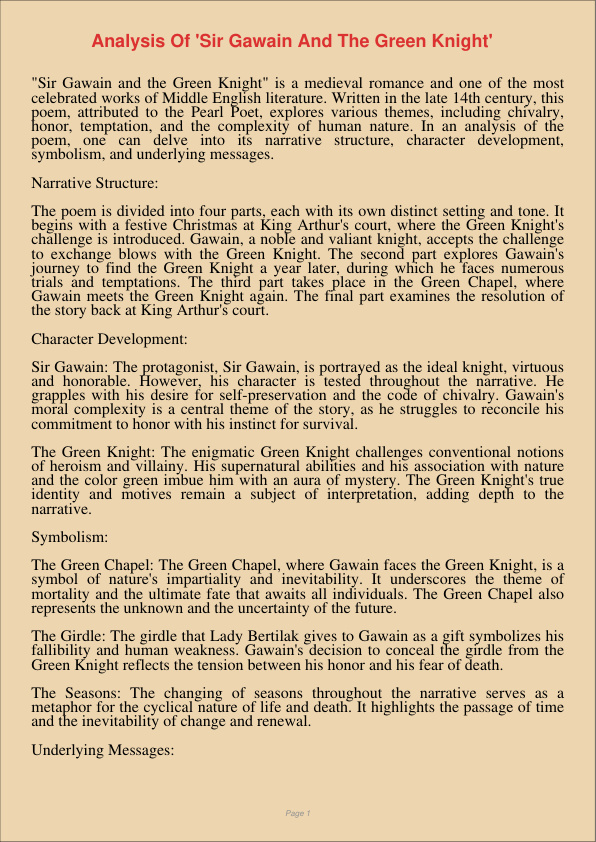
“Sir Gawain and the Green Knight” is a medieval romance and one of the most celebrated works of Middle English literature. Written in the late 14th century, this poem, attributed to the Pearl Poet, explores various themes, including chivalry, honor, temptation, and the complexity of human nature. In an analysis of the poem, one can delve into its narrative structure, character development, symbolism, and underlying messages.
Narrative Structure:
The poem is divided into four parts, each with its own distinct setting and tone. It begins with a festive Christmas at King Arthur’s court, where the Green Knight’s challenge is introduced. Gawain, a noble and valiant knight, accepts the challenge to exchange blows with the Green Knight. The second part explores Gawain’s journey to find the Green Knight a year later, during which he faces numerous trials and temptations. The third part takes place in the Green Chapel, where Gawain meets the Green Knight again. The final part examines the resolution of the story back at King Arthur’s court.
Character Development:
Sir Gawain: The protagonist, Sir Gawain, is portrayed as the ideal knight, virtuous and honorable. However, his character is tested throughout the narrative. He grapples with his desire for self-preservation and the code of chivalry. Gawain’s moral complexity is a central theme of the story, as he struggles to reconcile his commitment to honor with his instinct for survival.
The Green Knight: The enigmatic Green Knight challenges conventional notions of heroism and villainy. His supernatural abilities and his association with nature and the color green imbue him with an aura of mystery. The Green Knight’s true identity and motives remain a subject of interpretation, adding depth to the narrative.
Symbolism:
The Green Chapel: The Green Chapel, where Gawain faces the Green Knight, is a symbol of nature’s impartiality and inevitability. It underscores the theme of mortality and the ultimate fate that awaits all individuals. The Green Chapel also represents the unknown and the uncertainty of the future.
The Girdle: The girdle that Lady Bertilak gives to Gawain as a gift symbolizes his fallibility and human weakness. Gawain’s decision to conceal the girdle from the Green Knight reflects the tension between his honor and his fear of death.
The Seasons: The changing of seasons throughout the narrative serves as a metaphor for the cyclical nature of life and death. It highlights the passage of time and the inevitability of change and renewal.
Underlying Messages:
“Sir Gawain and the Green Knight” explores the complexities of human nature and the conflicts between personal desires and societal expectations. The poem challenges the ideals of chivalry by portraying a noble knight who is not without flaws. It suggests that even the most virtuous individuals may succumb to human weaknesses when faced with daunting challenges. The narrative encourages readers to reflect on the moral ambiguity of human actions and the capacity for growth and self-awareness.
In conclusion, “Sir Gawain and the Green Knight” is a rich and multi-layered narrative that engages with themes of chivalry, honor, temptation, and human frailty. It uses symbolism, character development, and narrative structure to convey its messages, making it a timeless and thought-provoking work of literature that continues to be studied and appreciated for its exploration of the complexities of human nature and the enduring struggle for moral integrity.
「真诚赞赏,手留余香」
真诚赞赏,手留余香
使用微信扫描二维码完成支付
